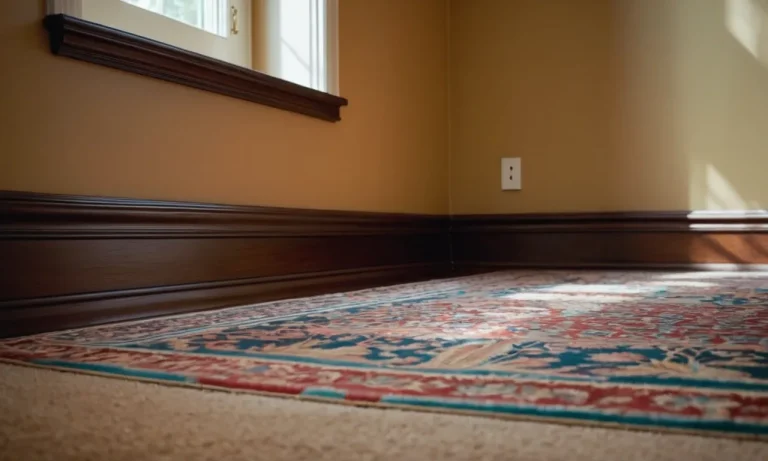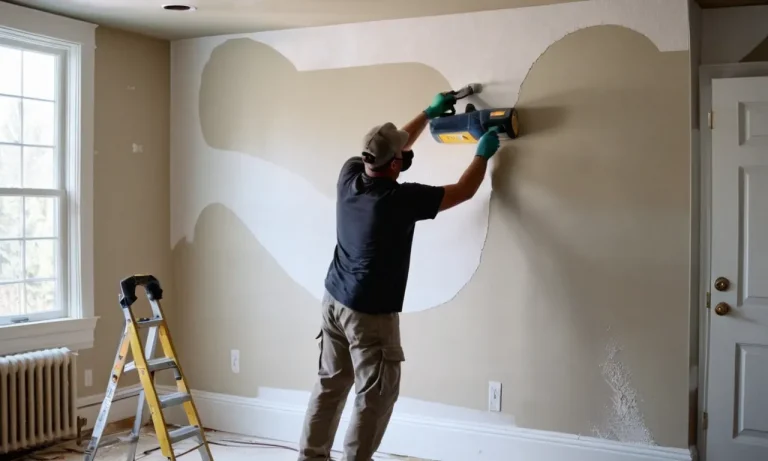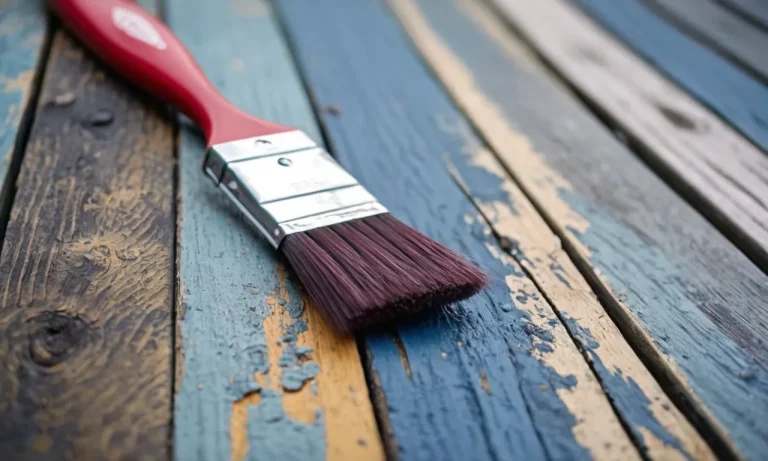Can You Paint A Rented Apartment? Everything You Need To Know
So you just moved into a new rental apartment, but the walls are looking a little dull. You’d love to liven up the place with a fresh coat of paint, but can you actually paint a rented apartment? Here’s a quick answer: in most cases, yes, you can paint a rented apartment if you get written permission from your landlord first.
However, there are usually rules around which colors you can choose and how to properly prep and paint the walls. Keep reading as we dive into everything you need to know about painting a rental, from asking your landlord for approval to how to paint like a pro so you get your security deposit back.
In this comprehensive guide, we’ll cover whether you need permission to paint, how to ask your landlord, rules around paint colors, prepping for painting, painting techniques to avoid damage, and how to get your security deposit back after painting your rental.
By the end, you’ll know exactly what to do so you can give your rental space a mini makeover while following your lease agreement and landlord’s rules.
Do You Need Your Landlord’s Permission to Paint a Rental?
When it comes to painting a rental apartment, it is important to understand that you typically need your landlord’s permission before picking up a paintbrush. Most rental agreements include clauses that prohibit tenants from making any alterations to the property without prior consent from the landlord.
This commonly includes painting the walls.
Painting a rental without asking is usually prohibited
Landlords often have valid reasons for prohibiting tenants from painting their rentals without permission. One of the main concerns is the potential for damage or poor-quality workmanship. If a tenant paints the walls without proper knowledge or experience, it can result in a subpar finish or even damage to the property.
Additionally, landlords may have specific color schemes or aesthetic preferences that they want to maintain throughout their rental properties.
Reasons landlords may say no
There are various reasons why a landlord may refuse permission to paint a rental. Some common reasons include:
- Preserving the property’s original condition for future tenants
- Ensuring consistency in the appearance of their rental properties
- Concerns about potential damage or poor-quality work
- Not wanting to deal with the hassle of approving and inspecting painting projects
What your lease says about painting
Your lease agreement is the best place to check whether painting is allowed or prohibited in your rental. It will outline the specific terms and conditions regarding alterations to the property. Some leases may explicitly state that painting is not allowed, while others may require written permission from the landlord before any painting can take place.
It is important to carefully review your lease agreement and communicate with your landlord if you are unsure about the painting policy. Open dialogue and clear communication can help avoid any misunderstandings or potential disputes.
Exceptions where permission may not be necessary
While it is generally necessary to seek permission from your landlord before painting a rental, there may be some exceptions where you might not need explicit permission. For example, if the walls are already in poor condition or have significant marks or stains, your landlord may be open to allowing you to paint them to improve their appearance.
Additionally, some landlords may have a more relaxed approach to painting and may allow tenants to paint as long as they return the walls to their original condition before moving out. However, it is always best to clarify with your landlord to avoid any potential issues.
Remember, it is always advisable to follow the terms of your rental agreement and obtain written permission from your landlord before making any changes to the property, including painting.
How to Ask Your Landlord for Permission
Ask politely in writing
When it comes to asking your landlord for permission to paint your rented apartment, it’s essential to do so in a polite and professional manner. Instead of simply mentioning it in passing or bringing it up during a casual conversation, consider writing a formal request letter.
This will not only demonstrate your seriousness but also provide a written record of your conversation, which can be useful for future reference. In your letter, be sure to explain why you want to paint, what colors you have in mind, and how it will enhance the overall aesthetics of the apartment.
Suggest paint swatches and offer to repaint when moving out
In order to alleviate any concerns your landlord may have about the painting process, it’s a good idea to suggest providing paint swatches for their approval. This will give them the opportunity to review and approve the colors you have in mind before any painting takes place.
Additionally, offering to repaint the apartment back to its original color when you move out can help reassure your landlord that there will be no long-term impact on the property’s value or appeal.
Offer to sign an agreement regarding painting
To further assure your landlord that you will handle the painting process responsibly, consider offering to sign an agreement regarding painting. This agreement can outline the specific details of the painting project, including the colors chosen, the timeframe for completion, and any additional terms or conditions that both parties agree to.
By formalizing the agreement, you can provide your landlord with peace of mind knowing that you are committed to maintaining the apartment’s condition and following any guidelines or restrictions they may have.
Paint Color Rules for Rental Apartments
Landlords often prohibit dark colors
When it comes to painting a rented apartment, it’s important to be aware of the rules set by your landlord. In many cases, landlords prohibit tenants from using dark colors on the walls. Dark colors can make a space feel smaller and may require multiple coats of paint to cover up when you move out.
It’s best to check your lease agreement or speak directly with your landlord to understand their specific guidelines regarding paint colors.
Stick to neutral or light tones
When you’re allowed to paint your rented apartment, it’s generally recommended to stick to neutral or light tones. These colors are versatile and can easily match different furniture and decor styles. Plus, they create a sense of openness and brightness in a space, making it appear larger and more inviting.
Shades of beige, gray, or off-white are popular choices for rental apartments.
Get approval for any colors before painting
Before you start painting your rented apartment, it’s crucial to get approval from your landlord or property management. Some landlords may have specific guidelines or restrictions on the colors you can use.
They may require you to use specific brands or finishes of paint to ensure easy touch-ups or maintenance. It’s always better to be safe than sorry, so make sure to communicate with your landlord and get their approval before making any changes to the apartment’s color scheme.
Preparing to Paint a Rental
Fill holes and cracks in walls
Before you start painting your rented apartment, it’s important to prepare the walls properly. One of the first steps is to fill any holes and cracks in the walls. You can use spackling paste or joint compound to fill in small holes, and a putty knife can help you smooth it out.
For larger holes, you may need to use a patching kit. By taking the time to fill these imperfections, you’ll ensure a smoother and more professional-looking paint job.
Clean walls, remove nails and adhesive
Another crucial step in preparing to paint a rental is to clean the walls thoroughly. Dust, dirt, and grime can prevent the paint from adhering properly, so it’s important to remove any debris. You can use a mild detergent and warm water solution to clean the walls, making sure to rinse them thoroughly and allow them to dry completely before painting.
Additionally, remove any nails or adhesive from the walls, as they can create bumps and uneven surfaces.
Tape off trim, floors, ceilings, and furniture
Properly taping off areas that you don’t want to paint is essential to achieving clean lines and avoiding any accidental splatters. Use painter’s tape to carefully tape off trim, floors, ceilings, and any other areas that you want to protect from paint.
Take your time and ensure that the tape is applied securely, as this will help prevent any paint bleeding and make the overall process much easier.
Cover floors and furniture with drop cloths
Painting can be a messy process, so it’s important to protect your floors and furniture from accidental spills and splatters. Lay down drop cloths or plastic sheets to cover the floors and furniture in the room you are painting. This will help catch any paint drips and make clean-up much easier.
Additionally, consider covering any large furniture pieces with plastic covers for added protection.
By following these steps, you’ll be well-prepared to paint your rented apartment without causing any damage or violating your lease agreement. Remember to always check with your landlord or property manager before making any changes to your rental unit. Happy painting!
Painting Tips to Avoid Damage
Use high-quality paint and primer
When painting a rented apartment, it is important to use high-quality paint and primer. This will not only ensure a professional finish but also help protect the walls from damage. High-quality paint is more durable and less likely to chip or peel, making it ideal for rental properties.
Additionally, using a primer will create a smooth surface for the paint to adhere to, resulting in a longer-lasting and more even finish.
Cut in edges with a brush before rolling
Before you start rolling the paint on the walls, it is essential to cut in the edges with a brush. This means painting the corners, edges, and areas around trim and moldings using a small brush. By doing this, you can achieve clean and precise lines, giving your painted walls a professional look.
Cutting in also allows you to reach areas that a roller might not be able to cover effectively.
Apply thin coats using a high nap roller
When applying the paint, it is recommended to use a high nap roller. This type of roller holds more paint and allows for better coverage. To avoid damage, it is important to apply thin coats of paint rather than thick ones.
Thin coats dry faster, reducing the chances of smudging or accidental damage while the paint is still wet. Additionally, multiple thin coats can create a more even and consistent color.
Let paint dry fully between coats
Patience is key when painting a rented apartment. It is crucial to let each coat of paint dry fully before applying another. Rushing the process can lead to smudges, streaks, or even paint peeling off. Follow the manufacturer’s instructions for drying times, and make sure the room is well-ventilated to help speed up the process.
This will ensure a smooth and durable finish that will last for years to come.
Clean up spills immediately
Accidents can happen, and it is important to be prepared for them. If you accidentally spill paint on the floor, furniture, or any other surface, make sure to clean it up immediately. Leaving the paint to dry can make it harder to remove and may result in permanent stains or damage.
Use a clean cloth or paper towel to blot the spill, and if necessary, consult the manufacturer’s instructions for specific cleaning recommendations.
Getting Your Security Deposit Back After Painting
One of the main concerns when painting a rented apartment is ensuring that you get your security deposit back. Landlords often have specific rules and regulations regarding painting, and it is important to follow them to avoid any deductions from your deposit.
Here are some tips to help you leave your walls looking professional and get your full deposit back:
Leave walls looking professional with no splatters
When painting your rented apartment, it is crucial to be careful and avoid any splatters or drips on the floors, ceilings, or furniture. Use drop cloths to cover the floor and any furniture that cannot be moved.
Take your time and use painter’s tape to protect areas that should not be painted, such as baseboards, door frames, and light switches. This will help you achieve a clean and professional finish, which will impress your landlord and increase the chances of getting your deposit back.
Remove paint from surfaces not intended to be painted
If you accidentally get paint on surfaces that were not intended to be painted, it is important to remove it promptly. Leaving dried paint on surfaces like windows, countertops, or tiles can result in damage and may lead to deductions from your security deposit.
Use a mild cleaning solution and a soft cloth to gently remove the paint without damaging the surface. If the paint does not come off easily, consider contacting a professional cleaner for assistance.
Repaint walls original color before moving out if required
Some landlords may require you to repaint the walls back to their original color before moving out. It is essential to familiarize yourself with your lease agreement and understand the specific requirements regarding painting.
If repainting is necessary, take the time to match the original color as closely as possible. Consider keeping a small sample of the original paint or consulting with a professional at a local paint store to ensure an accurate match.
By repainting the walls to their original color, you can avoid any deductions from your deposit.
Have landlord inspect walls and provide written approval
Before moving out, it is recommended to have your landlord inspect the painted walls and provide written approval that they are satisfied with the condition. This will serve as proof that you have followed the necessary guidelines and will help you in case there are any disputes regarding the return of your security deposit.
It is also a good idea to document the condition of the walls with photographs before moving out, as this can further support your case if needed.
Remember, communication with your landlord is key throughout the painting process. Make sure to discuss any painting plans and seek their approval if necessary. By following these tips and being mindful of the rules set by your landlord, you can increase your chances of getting your security deposit back after painting your rented apartment.
Conclusion
Painting your rental with landlord-approved paint gives you a chance to personalize your space. Just be sure to prep properly, paint carefully, clean up thoroughly, and restore walls to their original color when moving out.
With adequate planning and preparation, you can give your rental an exciting makeover while following all the rules in your lease agreement. Just get ready to lose that security deposit if you skip getting the OK from your landlord first or leave behind a mess.
Happy painting your new home away from home!
Now that you know exactly what to do every step of the way, you can feel confident painting your rental. Just be sure to get written approval from your landlord first, follow any guidelines they provide, and paint responsibly so you can get your full deposit back.
Here’s to a fresh new look in your rental apartment!







